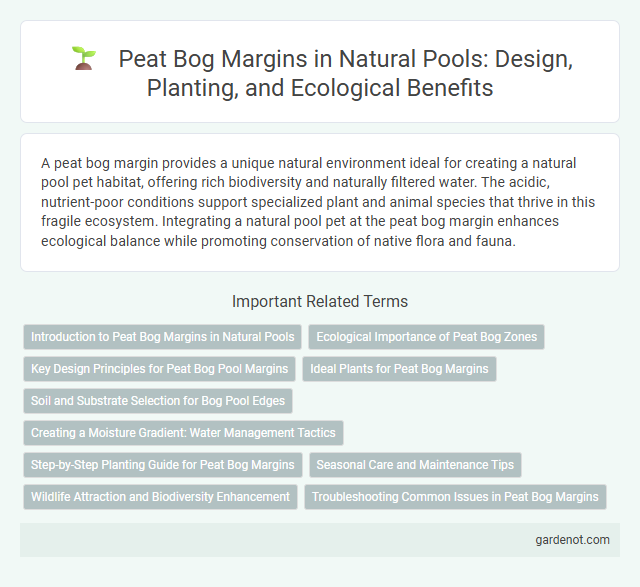A peat bog margin provides a unique natural environment ideal for creating a natural pool pet habitat, offering rich biodiversity and naturally filtered water. The acidic, nutrient-poor conditions support specialized plant and animal species that thrive in this fragile ecosystem. Integrating a natural pool pet at the peat bog margin enhances ecological balance while promoting conservation of native flora and fauna.
Introduction to Peat Bog Margins in Natural Pools
Peat bog margins in natural pools provide a unique ecological interface where water meets nutrient-rich, acidic peat soil, supporting specialized plant and microbial communities. These transitional zones play a crucial role in water filtration, carbon sequestration, and habitat diversity, enhancing the overall health of natural pool ecosystems. Preservation of peat bog margins is essential for maintaining the hydrological balance and biodiversity within peatland environments.
Ecological Importance of Peat Bog Zones
Peat bog margins serve as critical ecological zones that support diverse plant and animal species adapted to acidic, water-saturated conditions. These areas play a vital role in carbon sequestration, helping to mitigate climate change by storing large amounts of organic carbon in their waterlogged soils. The unique hydrology of peat bog zones also regulates water quality and maintains the natural balance of adjacent aquatic ecosystems in natural pools.
Key Design Principles for Peat Bog Pool Margins
Peat bog pool margins require careful consideration of water retention and nutrient balance to preserve the acidic, low-nutrient environment essential for native bog plants. Incorporating a gentle slope with organic peat substrates supports the growth of sphagnum moss and other specialized vegetation, promoting natural filtration and habitat stability. Maintaining a consistent water level through natural inflows and outflows ensures the ecological integrity and longevity of the peat bog pool margin.
Ideal Plants for Peat Bog Margins
Ideal plants for peat bog margins include Sphagnum mosses, cotton grass (Eriophorum spp.), and bog rosemary (Andromeda polifolia), all of which thrive in acidic, waterlogged soils. These species contribute to the natural filtration and stabilization of peat bog ecosystems, enhancing water quality and biodiversity. Their root structures and growth habits prevent erosion while supporting a diverse microhabitat for other wetland flora and fauna.
Soil and Substrate Selection for Bog Pool Edges
Choosing the right soil and substrate for peat bog margin in natural pools is essential to replicate the unique acidic and nutrient-poor conditions characteristic of bog ecosystems. A substrate rich in sphagnum peat, coarse sand, and organic matter promotes water retention while allowing proper aeration necessary for bog plant species. Avoiding nutrient-rich soils ensures the maintenance of bog-specific flora such as sundews and cotton grass at the pool's edges.
Creating a Moisture Gradient: Water Management Tactics
Creating a moisture gradient at the peat bog margin enhances natural pool water quality and biodiversity by managing water levels through controlled flooding and drainage techniques. Implementing precise water management tactics supports the slow release of nutrients and maintains optimal moisture conditions for peat-forming vegetation. These strategies stabilize the delicate ecosystem, promoting carbon sequestration and preventing erosion along the peat bog edge.
Step-by-Step Planting Guide for Peat Bog Margins
Planting peat bog margins requires carefully selecting native hydrophilic species like cotton grass (Eriophorum spp.), sundews (Drosera spp.), and bog mosses (Sphagnum spp.) that thrive in acidic, water-saturated soils. Begin by clearing invasive species and gently preparing the substrate to maintain natural water flow and soil structure, then sow seeds or transplant plugs during early spring when water levels stabilize. Regular monitoring and minimal disturbance encourage successful establishment, promoting biodiversity and natural filtration in the pool's ecosystem.
Seasonal Care and Maintenance Tips
Peat bog margins in natural pools require seasonal care to maintain water quality and plant health, with regular removal of dead vegetation during autumn to prevent nutrient buildup. Monitoring water levels and adjusting as needed helps preserve the peat's natural filtration properties throughout dry and wet seasons. Implementing targeted planting and gentle pruning supports biodiversity while minimizing erosion and sediment disturbance around the peat bog's edges.
Wildlife Attraction and Biodiversity Enhancement
Peat bog margins in natural pools create unique habitats that support a diverse range of flora and fauna, enhancing local biodiversity significantly. These areas attract specialized wildlife such as dragonflies, amphibians, and rare plant species that thrive in the acidic, nutrient-poor conditions characteristic of peat bogs. The presence of peat bog margins promotes ecological balance by providing crucial breeding grounds and food sources for many invertebrates and bird species.
Troubleshooting Common Issues in Peat Bog Margins
Peat bog margins in natural pools often face issues like waterlogging, nutrient imbalances, and invasive plant species encroachment. Managing water levels through controlled drainage and ensuring balanced nutrient input are critical to maintaining peat bog health and preventing algal bloom or vegetation die-off. Regular monitoring and targeted removal of invasive species help preserve the unique biodiversity and ecological function of peat bog margins.
Peat bog margin Infographic

 gardenot.com
gardenot.com